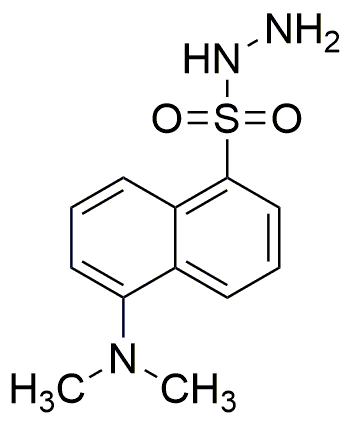Dansyl hydrazine is widely utilized in research focused on:
- Fluorescent Labeling: This compound is commonly used to label biomolecules, enabling researchers to track and visualize proteins and nucleic acids in various biological assays.
- Detection of Carbonyl Compounds: Dansyl hydrazine reacts with carbonyl groups, making it a valuable reagent for detecting aldehydes and ketones in organic synthesis and analytical chemistry.
- Cell Imaging: Its fluorescent properties allow for effective imaging of live cells, aiding in studies related to cell biology and drug delivery systems.
- Protein Structure Studies: By binding to specific amino acids, it assists in elucidating protein structures, which is crucial for understanding biological functions and developing pharmaceuticals.
- Environmental Monitoring: Dansyl hydrazine can be used in the analysis of environmental samples to detect and quantify pollutants, contributing to ecological research and safety assessments.
General Information
Properties
Safety and Regulations
Applications
Dansyl hydrazine is widely utilized in research focused on:
- Fluorescent Labeling: This compound is commonly used to label biomolecules, enabling researchers to track and visualize proteins and nucleic acids in various biological assays.
- Detection of Carbonyl Compounds: Dansyl hydrazine reacts with carbonyl groups, making it a valuable reagent for detecting aldehydes and ketones in organic synthesis and analytical chemistry.
- Cell Imaging: Its fluorescent properties allow for effective imaging of live cells, aiding in studies related to cell biology and drug delivery systems.
- Protein Structure Studies: By binding to specific amino acids, it assists in elucidating protein structures, which is crucial for understanding biological functions and developing pharmaceuticals.
- Environmental Monitoring: Dansyl hydrazine can be used in the analysis of environmental samples to detect and quantify pollutants, contributing to ecological research and safety assessments.
Documents
Safety Data Sheets (SDS)
The SDS provides comprehensive safety information on handling, storage, and disposal of the product.
Product Specification (PS)
The PS provides a comprehensive breakdown of the product’s properties, including chemical composition, physical state, purity, and storage requirements. It also details acceptable quality ranges and the product's intended applications.
Certificates of Analysis (COA)
Search for Certificates of Analysis (COA) by entering the products Lot Number. Lot and Batch Numbers can be found on a product’s label following the words ‘Lot’ or ‘Batch’.
*Catalog Number
*Lot Number
Certificates Of Origin (COO)
This COO confirms the country where the product was manufactured, and also details the materials and components used in it and whether it is derived from natural, synthetic, or other specific sources. This certificate may be required for customs, trade, and regulatory compliance.
*Catalog Number
*Lot Number
Safety Data Sheets (SDS)
The SDS provides comprehensive safety information on handling, storage, and disposal of the product.
DownloadProduct Specification (PS)
The PS provides a comprehensive breakdown of the product’s properties, including chemical composition, physical state, purity, and storage requirements. It also details acceptable quality ranges and the product's intended applications.
DownloadCertificates of Analysis (COA)
Search for Certificates of Analysis (COA) by entering the products Lot Number. Lot and Batch Numbers can be found on a product’s label following the words ‘Lot’ or ‘Batch’.
*Catalog Number
*Lot Number
Certificates Of Origin (COO)
This COO confirms the country where the product was manufactured, and also details the materials and components used in it and whether it is derived from natural, synthetic, or other specific sources. This certificate may be required for customs, trade, and regulatory compliance.


